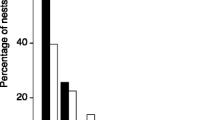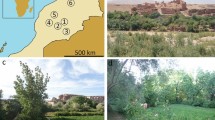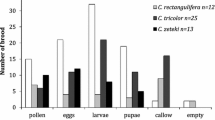Allodapine bees (family Apidae, subfamily Xylocopinae) provide substantial material for investigating the evolution of sociality because of their wide variation in colony size, life history traits, and caste differentiation. Two recent studies have shown that the Australian allodapine genus Brevineura exhibits a strong increase in per capita brood production (PCBP) in social colonies compared to single-female nests. However both species previously examined, B. xanthoclypeata and B. froggatti, show relatively few multi-female nests, which is puzzling considering the apparently large advantages for group-living in these species. Here we show that in a third species, B. elongata, there are also substantial benefits for group living, involving increased PCBP and a greatly reduced likelihood of nests without brood. As expected from these observations, we also found strongly female biased sex allocation. Nevertheless only a small percentage of nests contained more than one adult female, similar to the other two Brevineura species, raising the question of why multifemale colonies are not more common in this genus. Solving this puzzle will throw light on conditions that constrain sociality when group living apparently provides major advantages.





Similar content being viewed by others
References
Bull, N. J., and Schwarz, M. P. (1996). The habitat saturation hypothesis and sociality in an allodapine bee: cooperative nesting is not ‘‘making the best of a bad situation’’. Behav. Ecol. Soc. 39: 267–274.
Bull, N. J., and Schwarz, M. P. (2001). Brood insurance via protogyny: A source of female biased sex allocation. Proc. R. Soc. Lond. B. 268: 1869–1874.
Bull, N. J., Schwarz, M. P., and Cooper, S. J. B. (2003). Phylogenetic divergence of the Australian allodapine bees (Hymenoptera: Apidae). Mol. Phylogen. Evol. 27: 212–222.
Cronin, A. L., and Schwarz, M. P. (2001). Latitudinal variation in the sociality of allodapine bees (Hymenoptera: Apidae): sex ratios, relatedness and reproductive differentiation. Aust. J. Zool. 49: 1–16.
Field, J., Shreeves, G., Sumner, S., and Casiraghi, M. (2000). Insurance-based advantage to helpers in a tropical hover wasp. Nature 404: 869–871
Hogendoorn, K., and Schwarz, M. P. (1998). Guarding specialisation in pre-reproductive colonies of the allodapine bee Exoneura bicolor. Ethol. Ecol. Evol. 10(1): 67–77.
Hogendoorn, K., Watiniasih, N. L., and Schwarz, M. P. (2001). Extended alloparental care in the almost solitary bee Exoneurella eremophila. Behav. Ecol. Socio. 50: 275–282.
Houston, T. F. (1977). Nesting biology of three allodapine bee in the subgenus Exoneurella Michener (Hymenoptera: Anthophoridae). T. Roy. Soc. South Aust. 101: 99–113.
Hurst, P. S. (2002). Social biology of Exoneurella tridentata, an Australian allodapine bee with morphological castes and perennial colonies. Ph.D. Thesis. Flinders University of South Australia, Adelaide.
Joyce, N. C. (2001). Life cycle and social behaviour in south eastern Queensland populations of allodapine bees, Exoneura nr robusta, Brevineura elongata, and Braunsapis protuberans. Honours Thesis. Flinders University of South Australia, Adelaide.
Melna, P. A., and Schwarz, M. P. (1994). Behavioural specialisation in pre-reproductive colonies of the allodapine bee Exoneura bicolor (Hymenoptera: Anthophoridae). Insect. Soc. 41: 1–18.
Michener, C. D. (1965). The life cycle and social organization of bees of the genus Exoneura and their parasite Inquilina. U. Kansas. S. Bul. 46: 317–358.
Neville, T., Schwarz, M. P., and Tierney, S. M. (1998). Biology of a weakly social bee, Exoneura (Exoneurella) setosa (Hymenoptera: Apidae) and implications for social evolution in Australian allodapine bees. Aust. J. Zool. 46(3): 221–234.
O’Keefe, K. J., and Schwarz, M. P. (1990). Pheromones are implicated in reproductive differentiation in a primitively social bee. Naturwiss. 77: 83–86.
Reeve, H. K. (1991). Polistes. In Ross, K. G. and Matthews, R. W. (eds.), The Social Biology of Wasps, Cornell Univ. Press, Ithaca, pp. 99–148.
Silberbauer, L. X. (1997). The effect of non-synchronous dispersal on brood production in an allodapine bee, Exoneura bicolor Smith (Apidae, Allodapini). Insect. Soc. 44(2): 95–107.
Schwarz, M. P. (1986). Persistent multi-female nests in an Australian allodapine bee, Exoneura bicolor (Hymenoptera: Anthophoridae). Insect. Soc. 33(3): 258–277.
Schwarz, M. P. (1987). Intra-colony relatedness and sociality in the allodapine bee Exoneura bicolor. Behav. Ecol. Sociobiol. 21: 387–392.
Schwarz, M. P. (1988). Local resource enhancement and sex ratios in a primitively social bee. Nature 331: 346–348.
Schwarz, M. P. (1994). Female-biased sex ratios in a facultatively social bee and their implications for social evolution. Evolution 48(5): 1684–1697.
Schwarz, M. P., Lowe, R. M., and Lefevere, K. S. (1996). Kin association in the allodapine bee Exoneura richardsoni Rayment (Hymenoptera : Apidae). Aust. J. Entomol. 35: 65–71.
Schwarz, M. P., Bull, N. J., and Hogendoorn, K. (1998). Evolution of sociality in the allodapine bees: a review of sex allocation, ecology and evolution. Insect. Soc. 45: 349–368.
Schwarz, M. P., Fuller, S. Tierney, S. M., & Cooper, S. J. B. (in press) Molecular phylogenetics of the exoneurine allodapine bees reveal an ancient and puzzling dispersal from Africa to Australia. Sys. Biol.
Smith, A. R., Wcislo, W. T., and O’Donnell, S. (2003). Assured fitness returns favor sociality in a mass-provisioning sweat bee, Megalopta genalis (Hymenoptera: Halictidae). Behav. Ecol. Sociobiol. 54: 14–21.
Steen, Z., and Schwarz, M. P. (1998). Within-nest behaviour in a eusocial Australian allodapine bee Exoneura (Exoneurella) tridentata Houston (Apidae: Xylocopinae). T. R. Soc. South Aust. 122(1–2): 55–63.
Thompson, S., and Schwarz, M. P. (in press). Sociality and sex allocation in a tropical allodapine bee, Macrogalea candida. Biol. J. Linn. Soc.
Tierney, S. M., Cronin, A. L., Loussert, N., and Schwarz, M. P. (2000). The biology of Brevineura froggatti and phylogenetic conservatism in Australian allodapine bees (Apidae, Allodapini). Insect. Soc. 47: 96–97.
Tierney, S. M., Schwarz, M. P., and Adams, M. (1997). Social Behaviour in an Australian Allodapine Bee Exoneura (Brevineura) xanthoclypeata (Hymenoptera: Apidae). Aust. J. Zool. 45: 385–398.
Queller, D. C. (1989). The evolution of eusocialty: Reproductive head start of workers. P. Natl. Acad. Sci. USA 86: 3224–3226.
Queller, D. C. (1994). Extended parental care and the origin of eusociality. Proc. R. Soc. Lond. B 256: 105–111.
ACKNOWLEDGMENTS
We thank Nick Bull for substantial help and direction during this project. We also thank Nick Bull, Simon Tierney and Zeta Steen for help with field work. We thank Mary Lyons for helpful comments on this manuscript. This project was supported by Australian Research Council grants to M. Schwarz.
Author information
Authors and Affiliations
Corresponding author
Rights and permissions
About this article
Cite this article
Joyce, N.C., Schwarz, M.P. Sociality in the Australian Allodapine Bee Brevineura elongata: Small Colony Sizes Despite Large Benefits to Group Living. J Insect Behav 19, 45–61 (2006). https://doi.org/10.1007/s10905-005-9004-1
Accepted:
Published:
Issue Date:
DOI: https://doi.org/10.1007/s10905-005-9004-1




